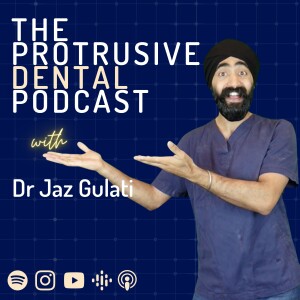
Cracked Teeth Management with the Direct Composite Splint Technique – PDP098
 2021-11-30
2021-11-30
Download
Right click and do "save link as"
How do you manage cracks? The 'Direct Composite Splint Technique' is kind of controversial. Whilst it may seem intuitive to take cracked teeth OUT of the occlusion, this technique builds composite on top of the cracked tooth in to SUPRA-Occlusion. So what's the crack? (Sorry) - I brought on the pioneers of DCS, Professor Shamir Mehta and Dr. Subir Banerji who enlighten us about this minimally invasive technique.
https://www.youtube.com/watch?v=SpkrUBIJji4
Have you subscribed on Youtube yet?!
Need to Read it? Check out the Full Episode Transcript below!
Protrusive Dental Pearl: Get the largest magnification loupes you can afford and you can think you can sustain. I personally use 7.5x for EVERYTHING! A sharp probe has a resolution of 40 microns, at 8x magnification the resolution is 25 microns. We need high magnification to treat cracks!
In this episode we discussed:
What is the Direct Composite Splint Technique? 9:23Decision making and Sequencing of Direct Composite Splint Technique 11:05DCS Technique protocol in term of of thickness and bonding 16:54Aiding disclusion with canine risers 19:55 DCS Technique Protocol 22:20How does DCS Technique work in terms of the relative actual movement? 27:15Patient Communication for Cracked Teeth 33:22Re-established occlusion after DCS? 42:53Are you sure we can leave it in Supra-Occlusion? 50:55Should you chase cracks? 54:33Favourite Sectional Matrix Bands 56:56Tips and Tricks in making patients comfortable 58:25
Check out this paper by Professor Shamir Mehta and Dr. Subir Banerji about DCS Technique
Cracked-tooth-syndrome-Part-1Download
Cracked-tooth-syndrome-Part-2-1Download
Check out the PG Dip / Master's in Advanced Aesthetic and Restorative Dentistry:
Aesthetic-Dentistry-PGDipDownload
If you enjoyed this episode, you will love I Hate Cracked Teeth with Kreena Patel
Click below for full episode transcript:
Opening Snippet: I would encourage you to read more about it before you actually do it. And it may even save you from a tricky situation. Even if you just use it diagnostically, ie, you suspect there's a cracked tooth, you then place the composite on top, and now the pain goes away. That is a diagnostic event. So even if you don't think you're gonna go the full hog and use this technique because it's too controversial for you, I think you can still use it as a diagnostic aid...
Jaz' Introduction: Hello, Protruserati. I'm Jaz Gulati. And welcome back to another episode of The Protrusive Dental podcast. On this episode, today, we're talking about something called The Direct Composite Splint Technique for managing cracked teeth. Now, if this is the first time that you're coming across this, it is a completely alien, weird, crazy concept like the first time I came across this, like, you know, our natural instinct when managing crack teeth is to take it out of occlusion, right? You see a crack, ah, let me remove it out of occlusion. But what this technique actually does is the opposite, it actually puts that same cracks tooth in Supra occlusion, right? And by doing that, you will by wrapping some composite over the crack molar, let's say, basically prevents the cusps from flexing and therefore maintaining the crack rather than allowing it to propagate. So that's how it works. And then to even add the controversies of this technique, what happens over time is that, that composite is left in the patient's mouth over the offending tooth, the cracked tooth, right? And then what happens over time is what we call relative actual movement. So that tooth, which is proud in the bite, eventually, over time is no longer proud in the bite. And suddenly, it's almost pretty much in the patient's maximum intercuspal position. So that when you remove that composite, you now have restorative space. Now, if I've gone too fast then don't worry, we've got a whole hour or something with two leading experts on this technique. So if you're listening,
view more
More Episodes
Is Caries Detector Dye BS? – PDP138
 2023-01-25
2023-01-25
 2023-01-25
2023-01-25
Hygienists are NOT Scaling Machines – IC034
 2023-01-19
2023-01-19
 2023-01-19
2023-01-19
Success with Resin Bonded Bridges – PDP132
 2022-12-03
2022-12-03
 2022-12-03
2022-12-03
012345678910111213141516171819
Create your
podcast in
minutes
- Full-featured podcast site
- Unlimited storage and bandwidth
- Comprehensive podcast stats
- Distribute to Apple Podcasts, Spotify, and more
- Make money with your podcast
It is Free
- Privacy Policy
- Cookie Policy
- Terms of Use
- Consent Preferences
- Copyright © 2015-2024 Podbean.com




